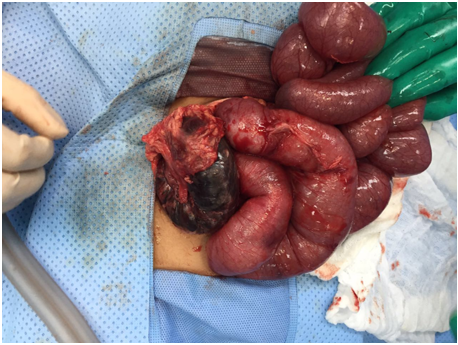MOJ
eISSN: 2381-179X


Case Report Volume 10 Issue 3
Pediatric surgery department, King fahad armed forces hospital, Saudi Arabia
Correspondence: Alshaima Alghamdi, pediatric surgery department, King fahad armed forces hospital, Saudi Arabia
Received: May 11, 2020 | Published: May 21, 2020
Citation: Alghamdi A, Raboei E. Perforated Meckel’s diverticulum by chicken bone associated with terminal ilial volvulus in a child, a case report. MOJ Clin Med Case Rep . 2020;10(3):61-63. DOI: 10.15406/mojcr.2020.10.00344
Foreign body ingestions are a common occurrence in children. The initial presentation can vary from the child being completely asymptomatic to a variety of symptoms. Perforation of Meckel’s diverticulum by foreign bodies is a rare cause of acute abdomen. It is usually diagnosed intra operative. We here in report on an unusual a case of 3-year-old male child who came to the Emergency department with diffuse abdominal pain associated with bilious vomiting and diarrhea. The initial diagnosis was acute small bowel obstruction. After exploration, it turned out to be perforated Meckel's diverticulum caused by a swallowed chicken bone.
Keywords: perforated Meckel’s diverticulum, foreign body ingestions, volvulus
Meckel's diverticulum is the commonest congenital abnormality of the gastrointestinal tract.1 It is caused by failure of the omphalomesenteric duct to recede during gestational weeks 5–7.2 It is linked with the name of Johann Frederick Meckel, who in 1812 first described it accurately.3 Meckel’s diverticulum is a true diverticulum because its’ wall containsall the layers found in normal intestine. Most of the affected children are asymptomatic. Only 2% of those children who have Meckel's diverticulum are symptomatic and they tend to be typically below the age of two years. The common presentation associated with symptomatic Meckel's diverticula is bleeding, followed by intestinal obstruction, inflammation, intussusceptions, neoplasm and rarely perforation.4 Hemorrhage is the most frequent complication of this condition in the pediatric population and arises secondary to ulceration caused by acid secretion from ectopic mucosa. complications appear more frequently among males, with a reported three to four times greater incidence in males.5 We here in report on an unusual case of A 3-year-old boy who presented with a perforated Meckel's diverticulum caused by a swallowed chicken bone.
A 3-year-old male child presented to our emergency department with the complain of diffuse abdominal pain, biliousvomiting, and diarrhea for 2 days before presentation. He vomited several times moderate amount of green fluid. He had no previous abdominal operations and his medical history was otherwise unremarkable. Upon examination, the patient was conscious, he had tachycardia (heart rate of 139/minute), tachypnea (respiratory rate of 29/minute) with 100% oxygen saturation. The blood pressure was 93/43mmHg and temperature 37.3°C. He looked ill and in pain, was lying still on bed without movement. His abdomen was grossly distended, not moving with respiration. It was diffusely tender on palpation with maximal tenderness in right iliac fossa. Plain abdominal x-ray showed multiple air fluid levels. Abdominal ultrasound showed complex mass in right iliac fossa. Initial laboratory workup revealed high C reactive protein (26.1) and normal leucocyte count (5.2). The initial impression was acute small bowel obstruction. The patient was kept fasting. He received a bolus of 20ml/kg normal saline along with maintenance of dextrose 5% in normal saline. Foley catheter and nasogastric tube were inserted to calculate output. He was taken to the operating room for exploration. Through a camera port inserted in the umbilicus, the abdomen was initially explored. Small bowel was found to be dilated and a gangrenous part was noted. The procedure was converted to laparotomy through a right transverse incision. To our surprise, we found a perforated Meckel's diverticulum by chicken bone. In addition, there was a terminal ileal volvulus with a gangrene attached to an adhesional band. a wedge resection of the Meckel's diverticulum was done using Endo GIAstapler, along with resection of 15 cm of the gangrenous terminal ilium, cecum, and appendix. An Ileo-colonic anastomosis was performed, and the abdomen was thoroughly washed with normal saline before closure. The patient received prophylactic doses of metronidazole and cefuroxime both before operation and continued post operatively. He was kept fasting and started TPN postoperatively. He started to drink clear fluid on 4thpost-operativeday, and started to pass loose black stool multiple times from the second post-operative day (His hemoglobin was stable at 11.9) the patient was discharged home in good condition on 8th post-operative day. On his outpatient follow up visits after discharge, he did well with no recurrent symptoms, with no further episodes of abdominal pain or vomiting.
Foreign body (FB) ingestions are a common occurrence in children. The exact incidence is unknown. The reported ingested objects include toys, batteries, needles, pins, screws, jewellery, pencils, glass, cherrystones, wood splinters, fruit seeds, fish and chicken bones.6
An exceedingly small percentage of ingested foreign bodies can cause perforation of the bowel, leading to symptoms and signs of acute abdomen requiring surgical intervention. The presentation of perforated Meckel's diverticulum is usually that of an acute abdomen that necessitates surgical intervention. It is commonly assumed to be acute appendicitis, and it is usually diagnosed intra operative.7

Figure 1 Intraoperative picture. The gangrenous terminal ilium is shown (solid arrow). The perforated Meckel's diverticulum with chicken bone is hiding in between the loops (dashed arrow).

Figure 2 Intraoperative picture. Chicken bone perforating the Meckel's diverticulum is shown (solid arrow).
Perforation of Meckel’s diverticulum by foreign bodies is a rare cause of acute abdomen. The first reported case of perforated Meckel's diverticulum was in 1851 by Denunce(Post-mortem diagnosis).8 A recent review by Banerjee and colleagues found 79 case reports of perforated Meckel's diverticulum by foreign bodies. Fish bone was the commonest foreign body (45%) but perforation due to chicken bone was very rare with only 7 cases reported in English literature, including on epediatric case.9 Of those 79 case reports, only 24 cases were among pediatric population (<18years). There was a significant male preponderance (82.3%) and the youngest patient was 1 year old. In most patients, history of an ingested foreign body was lacking. Hence, it was difficult to suspect this condition. To the best of the authors' knowledge, this is the first reported case of a perforated Meckel’s diverticulum by chicken bone in a child <10 years old, with associated ilial volvulus.
Our patient had pronounced signs of peritonitis. The parents did not report on any foreign body ingestion upon presentation. Because clinical, laboratory and imaging features of complicated Meckel’s diverticulum are not pathognomonic, the preoperative diagnosis is rarely established. We could identify the exact pathology only after operative exploration. After we searched the literature, we found only 4 children in whom such diagnosis was made before operation, all of them were known to have ingested foreign bodies (button battery and metallic balls).9
Management of complicated Meckel’s diverticulum consists of diverticulectomy in the majority of cases, along with antibiotics and peritoneal irrigation in case of localized or generalized peritonitis.10 Surgical intervention should not be delayed by supplementary radiographic imaging in patients with peritonitis. In most of the previously reported cases, the diverticulum along with a segment of adjoining bowel was resected and end-to-end anastomosis was done during exploratory Laparotomy.9 Our patient was managed by wedge resection of the diverticulum, resection of the gangrenous terminal ilium, cecum, and appendix with an Ileo-colonic anastomosis. The volvulus-which was distal to the perforated Meckel’s diverticulum - is presumed to be related to the chicken bone pressing on the adjacent mesentery and forming an adhesional band with ilium.
This case represents an example of a preoperative diagnostic dilemma of a child with worsening abdominal pain suspected of bowel obstruction in which a perforated Meckel’s diverticulum by an intact chicken bone was diagnosed appropriately after laparotomy.
The presentation of perforated Meckel's diverticulum can sometimes be confused with appendicitis. To the best of the authors' knowledge, this is the first reported case of a perforated Meckel’s diverticulum by chicken bone in a child<10 years old, with associated terminalilial volvulus. The ingested foreign body can also cause injury to adjacent bowel when it protrudes from the perforated lumen.
Consent to publish the case report was not obtained. This report does not contain any personal information that could lead to the identification of the patient.
No funding or grant support.
None.

©2020 Alghamdi, et al. This is an open access article distributed under the terms of the, which permits unrestricted use, distribution, and build upon your work non-commercially.